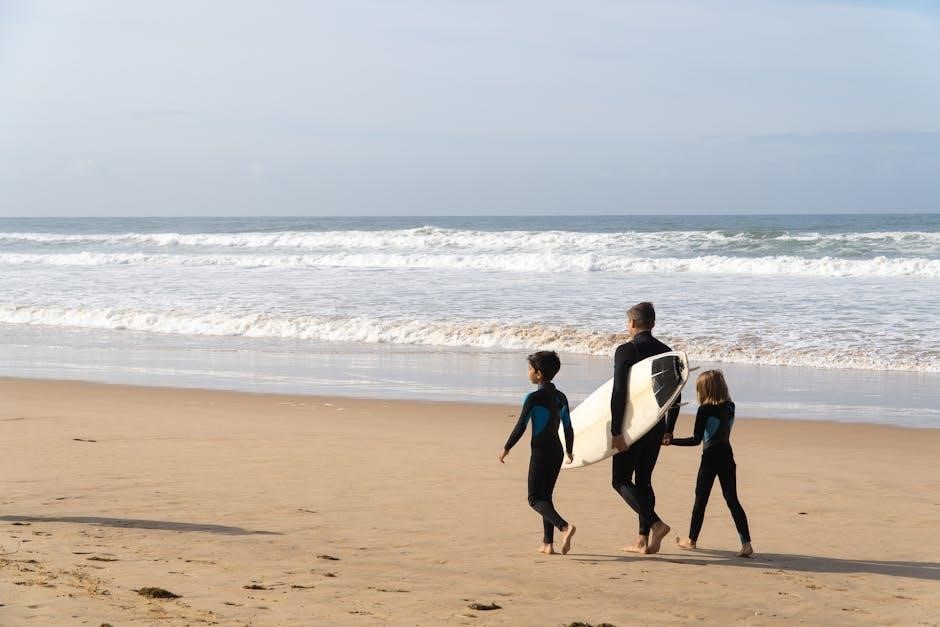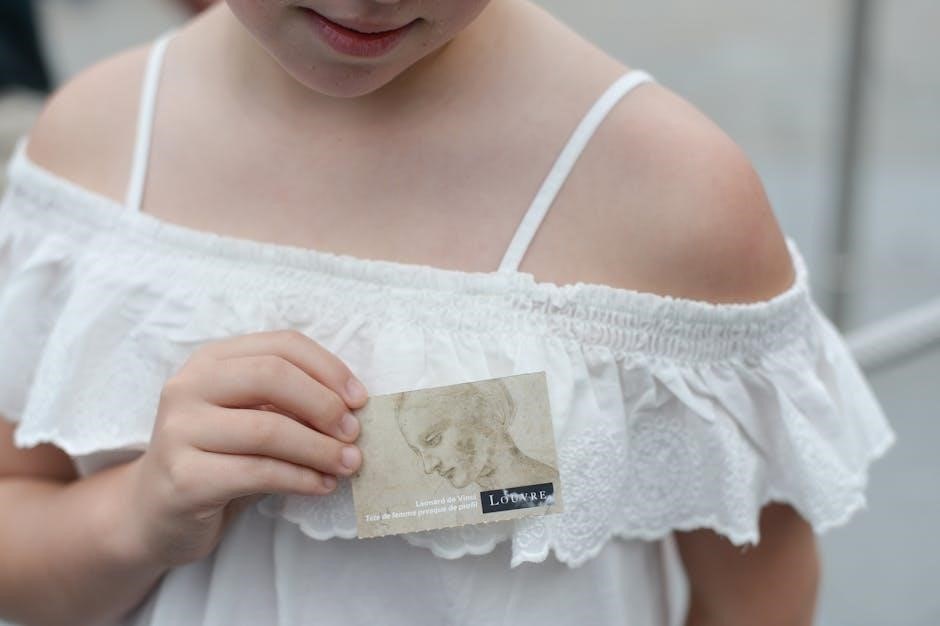
The Gallery Walk Activity is an engaging, student-centered strategy where learners explore diverse texts, images, or projects displayed around the classroom. It fosters critical thinking, collaboration, and creativity, allowing students to share insights and gain multiple perspectives. This interactive approach is widely used across various subjects to enhance understanding and participation.
1.1 What is a Gallery Walk?
A Gallery Walk is an interactive, student-centered activity where learners explore multiple texts, images, or projects displayed around the classroom. It involves movement and discussion, as students rotate through stations to analyze and respond to the materials. This structured discussion strategy allows participants to engage deeply with content, share insights, and gain diverse perspectives. Often used in various subjects, it encourages critical thinking, collaboration, and creativity. The activity is adaptable, making it suitable for different age groups and educational goals. By fostering active participation, it creates a dynamic learning environment that promotes engagement and understanding.
1.2 Purpose and Benefits of the Activity
The Gallery Walk activity is designed to enhance student engagement and foster collaboration by encouraging active participation and peer interaction. Its primary purpose is to create a dynamic learning environment where students can explore diverse perspectives and ideas. This activity promotes critical thinking, as students analyze and interpret various texts or images. It also allows teachers to informally assess student understanding and encourage creativity. By involving movement and discussion, it caters to kinesthetic learners and breaks the monotony of traditional classroom settings. Additionally, it builds confidence as students share their thoughts and learn from one another, making it a valuable tool for fostering a sense of community and shared knowledge.

Structure of the Gallery Walk Worksheet

The Gallery Walk worksheet typically includes key components such as rating scales, evaluation criteria, and space for student reflections. It is designed to guide structured analysis and feedback, ensuring focused participation and meaningful interaction with the activity’s content. The worksheet often features clear instructions, categories for assessment, and prompts to encourage critical thinking and collaboration. Its format varies depending on the subject and grade level but always aims to facilitate engagement and deeper understanding of the materials presented during the Gallery Walk.
2.1 Key Components of the Worksheet

The Gallery Walk worksheet typically includes rating scales, evaluation criteria, and spaces for reflections and feedback. Rating scales, such as 1-5, help students assess aspects like safety, structure, or creativity. Evaluation criteria guide students on what to focus on, ensuring consistent assessments. Reflection sections allow students to write thoughts or opinions about the material, fostering deeper engagement. Feedback areas enable peer interaction, promoting collaboration. The worksheet may also include guided questions to direct analysis and organizational features like clear headings for ease of use; These components ensure the activity is structured, fostering critical thinking and meaningful participation.
2.2 Rating Scales and Evaluation Criteria
Rating scales are integral to the Gallery Walk worksheet, providing a structured method for students to evaluate materials. Typically, scales range from 1 to 5, with 1 being “Very Poor” and 5 “Excellent.” Evaluation criteria vary by subject, such as assessing safety, structure, creativity, or historical accuracy. Clear definitions for each rating ensure consistency. For example, in STEM, criteria might include innovation and practicality, while in poetry, emotional impact and imagery might be focused on. These tools help students provide focused feedback, guiding their analysis and discussion during the activity, and ensuring assessments are meaningful and aligned with learning objectives.
How to Set Up a Gallery Walk Activity
Prepare materials by selecting relevant images or texts aligned with the lesson. Arrange the classroom to display these items prominently, ensuring accessibility for all students. Provide clear instructions and a worksheet for structured participation, fostering an engaging and interactive learning environment.
3.1 Preparing Materials and the Classroom
Begin by selecting relevant images, texts, or projects that align with your lesson objectives. Print and display these materials prominently around the classroom, ensuring visibility for all students. Prepare a Gallery Walk worksheet with prompts or questions to guide student analysis, such as describing observations, interpreting meanings, or rating specific criteria. Arrange the room to facilitate movement, creating stations or clusters for each display. Ensure each station has a clear focus and sufficient space for students to gather. Provide writing tools and distribute the worksheet at the start of the activity to ensure readiness. Finally, test the layout to ensure smooth navigation and accessibility for all participants.
3.2 Instructions for Students
Students begin by moving around the room to examine each displayed image, text, or project. They are instructed to carefully evaluate each piece, using the provided worksheet to record their observations, thoughts, and ratings. For each station, students should complete the designated tasks, such as describing what they see, interpreting the content, or rating specific criteria (e.g., safety, structure, or creativity). Encourage students to discuss their findings with peers, fostering collaboration and diverse perspectives. After completing the worksheet, students should return to their seats or submit their work for review. Ensure clear time limits are communicated to maintain structure and focus throughout the activity.
Applying the Gallery Walk Activity Across Subjects
The Gallery Walk Activity is versatile and can be applied to various subjects, including STEM, Language Arts, and Social Studies. The worksheet is used to analyze texts, images, or projects, fostering critical thinking and collaboration across disciplines.
4.1 STEM Subjects (Science, Technology, Engineering, Math)
In STEM subjects, the Gallery Walk Activity is used to analyze scientific concepts, engineering designs, and mathematical problems. Students evaluate projects or models displayed around the classroom, rating factors like safety, structure, and functionality on a scale from 1 to 5. This approach encourages peer collaboration and critical thinking. For example, in a lesson on roller coasters, students assess safety, structural integrity, and fun factor, promoting hands-on learning and practical application of STEM principles. The worksheet serves as a tool for structured feedback and idea sharing, enhancing overall understanding and innovation.
4.2 Language Arts and Poetry
In Language Arts and Poetry, the Gallery Walk Activity enhances literary analysis and creative expression. Students are provided with a worksheet to record their thoughts and reflections as they explore displayed poems or texts. This interactive approach allows learners to engage deeply with poetry, fostering a deeper appreciation and understanding. By rotating through stations, students can share insights and interpretations, encouraging collaborative learning. The activity is particularly effective for fostering critical thinking and creativity, as students analyze and respond to poetic devices, themes, and imagery. This method also supports differentiated instruction, catering to diverse learning styles and promoting meaningful engagement with literary works.

4.3 Social Studies and History
In Social Studies and History, the Gallery Walk Activity offers an interactive way to explore historical events, cultural practices, and geographic concepts. Students analyze images, primary sources, or artifacts displayed around the room, using worksheets to record observations and reflections. This method encourages critical thinking and collaboration as learners discuss historical themes and connect past events to contemporary issues. Teachers can incorporate diverse perspectives, fostering empathy and understanding. The activity also supports differentiated instruction, allowing students to engage with content at their own pace. By integrating visual and textual elements, the Gallery Walk Activity makes complex historical concepts accessible and engaging for all learners.

Tips for Creating an Effective Gallery Walk
Ensure the classroom is well-organized with clearly displayed materials, fostering easy navigation. Provide detailed worksheets and encourage active participation to maximize engagement and learning outcomes effectively.
5;1 Choosing Relevant Images or Texts
Selecting appropriate images or texts is crucial for a successful Gallery Walk. These materials should align with the lesson’s objectives and resonate with students’ interests to ensure engagement. Use high-quality, visually appealing images that spark curiosity. For texts, choose excerpts that are thought-provoking and age-appropriate. Ensure diversity in perspectives to encourage broad discussion. Consider using historical photographs, diagrams, or poems, depending on the subject. The chosen materials should be clear and accessible, allowing students to easily interpret and connect with them. This careful selection enhances the activity’s effectiveness and promotes meaningful interactions among participants.
5.2 Encouraging Student Participation and Engagement

To maximize engagement, ensure students have clear instructions and a structured worksheet to guide their interactions. Encourage movement and collaboration by allowing students to work in small groups, sharing insights and discussing their interpretations. Provide prompts or open-ended questions to stimulate critical thinking and creativity. Teachers should circulate to offer support and encourage quieter students to contribute. Positive reinforcement and a supportive classroom environment can motivate participation. Incorporate interactive elements, like note-taking or reflection sections, to keep students focused. Allowing time for students to present their findings fosters a sense of ownership and accountability, making the activity more engaging and effective for all learners.

Using the Gallery Walk as a Teaching Tool
The Gallery Walk Activity is a versatile teaching tool that promotes critical thinking, collaboration, and active learning. It allows teachers to assess student understanding effectively.
6.1 Promoting Critical Thinking and Collaboration
The Gallery Walk Activity is an excellent way to foster critical thinking and collaboration among students. By engaging with diverse texts, images, or projects, students are encouraged to analyze, compare, and evaluate information. This interactive approach promotes deeper understanding as learners discuss and share their interpretations with peers. Collaboration is enhanced through group discussions, where students build on each other’s ideas and gain multiple perspectives. The activity also encourages active listening and respectful dialogue, creating a dynamic learning environment. These interactions help students develop essential skills such as problem-solving, communication, and teamwork, which are crucial for academic and real-world success.
6.2 Assessing Student Understanding
The Gallery Walk Activity provides teachers with meaningful ways to assess student understanding. By observing student participation and listening to their discussions, educators can gauge comprehension and identify misconceptions. The worksheet serves as a tangible tool, allowing teachers to evaluate the depth of analysis and critical thinking. Students’ written feedback and ratings on the worksheet offer insights into their grasp of the material. Additionally, peer interactions during the activity reveal how well students can articulate their thoughts and engage with others’ perspectives. This approach allows for formative assessment, helping teachers adjust instruction to address learning gaps and strengthen student understanding in real-time.
The Gallery Walk Activity fosters critical thinking and collaboration through interactive analysis of diverse materials. The worksheet structures reflections, enhancing comprehension and engagement.

7.1 Summary of the Gallery Walk Activity
The Gallery Walk Activity is an interactive and engaging educational strategy where students explore and analyze diverse materials, such as texts, images, or projects, displayed around the classroom. By rotating through stations, learners develop critical thinking and collaboration skills, sharing insights and gaining multiple perspectives. The activity is supported by worksheets that guide reflection and structured feedback, making it adaptable across subjects like STEM, Language Arts, and Social Studies. Its versatility and student-centered approach make it a valuable tool for fostering deeper understanding and active participation in learning environments.
7.2 Final Thoughts on Implementing the Worksheet
Implementing the Gallery Walk worksheet is a powerful way to enhance student engagement and understanding. It provides structured guidance for learners to reflect, analyze, and evaluate materials effectively. The worksheet’s adaptability across subjects and age groups makes it a versatile tool for educators. By encouraging active participation and peer interaction, it fosters a collaborative learning environment. Teachers can tailor the worksheet to meet specific objectives, ensuring relevance and depth. The activity’s success lies in its ability to make learning interactive and meaningful, helping students develop critical thinking and communication skills. Ultimately, the Gallery Walk worksheet is a valuable resource for creating dynamic and impactful lessons.